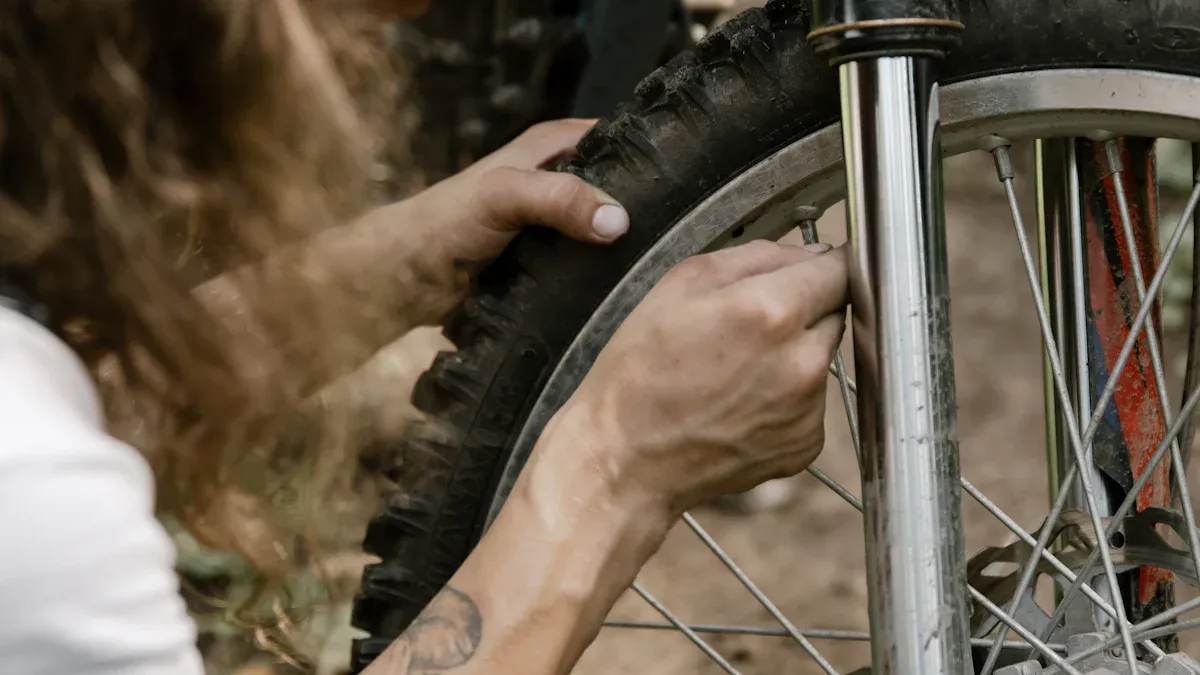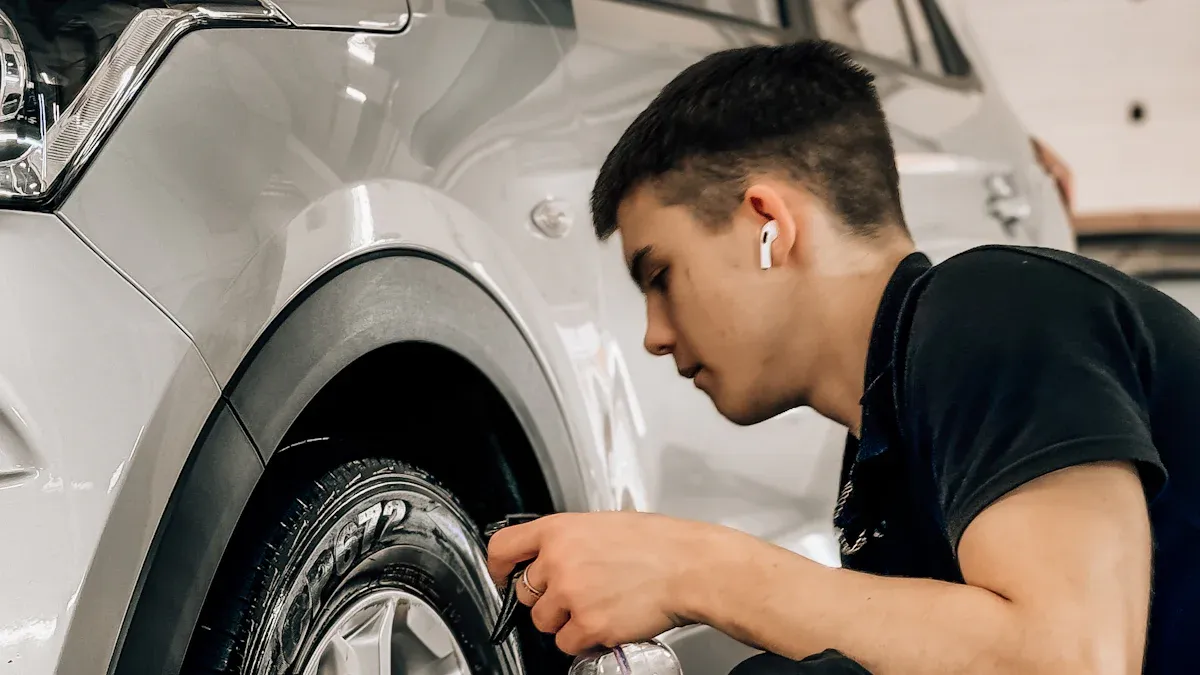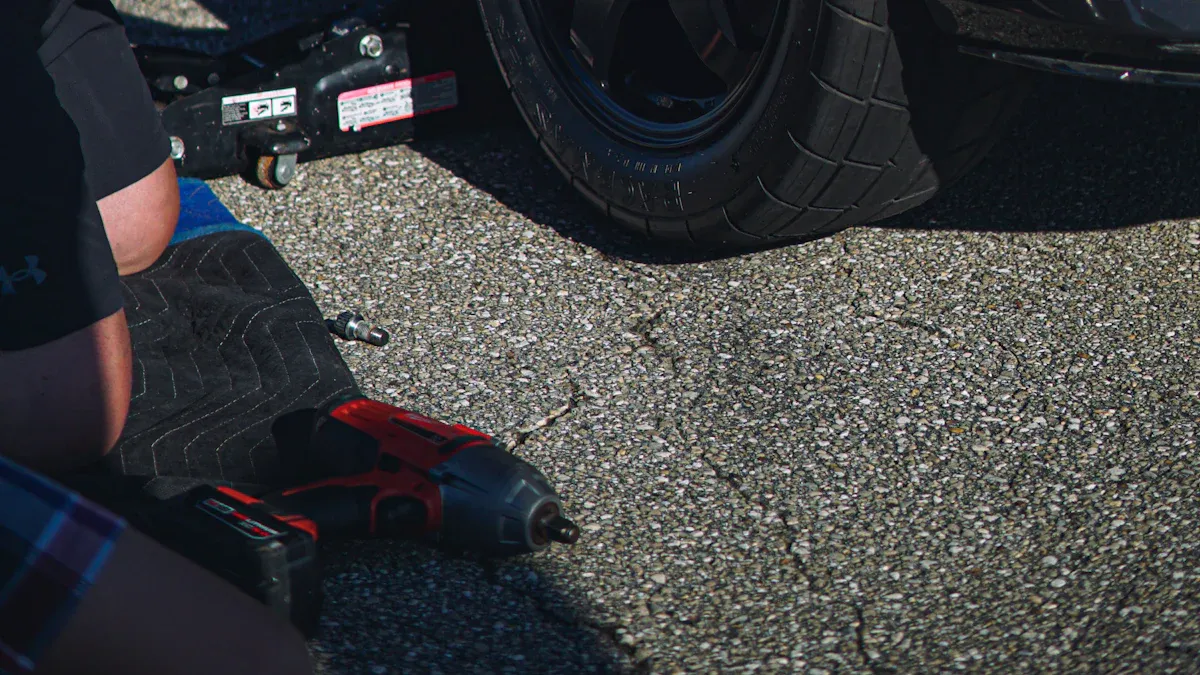
If you want to fix a flat tire, a tyre patch gives you a strong and lasting repair. Most flat tires happen because of small nails or sharp objects stuck in the tread. You can fix these slow leaks by removing the tire, finding the puncture, and applying a patch that seals the hole. Using a quality product like Sunsoul helps you get a reliable repair every time. Sunsoul rubber tire patch works well because they bond tightly and keep your tire safe on the road.
Key Takeaways
Use the right tools like tire levers, rubber cement, and a good rubber tube patch kit like Sunsoul. These tools help make your tire repair strong and last longer.
Find the hole in the tire and mark it. Clean the spot well and roughen it before you put on the patch. This helps the patch stick tightly.
Spread rubber cement evenly on the area. Press the patch down hard from inside the tire. Hold it in place so the fix is strong and does not leak.
Always check your repair by filling the tire with air. Look for leaks using soapy water or by putting the tire in water.
Sometimes you should replace the tire instead of patching it. Do this if the damage is big, on the sidewall, or if the tire has been fixed many times.
Tyre Patch Tools and Materials
Essential Tools
Before you start any tire repair, you need the right tools and materials. Having a good rubber tube patch kit makes the job much easier. Here’s what you should have ready:
Tire levers – These help you remove the tire from the rim.
Awl – Use this to check the puncture and clear out debris.
Tire crayon – Mark the spot where you find the hole.
Scraper or sandpaper – Clean and roughen the area around the puncture.
Low-speed buffer or scuffer – Buff the surface for better patch adhesion.
3/16-inch carbide cutter – Ream the injury if needed.
Pulling wires – Insert repair plugs if your patch kit includes them.
Knife – Trim any excess material.
Stitcher – Press the tyre patch firmly onto the tire.
Rubber cement – This glue helps the patch stick and seal the repair.
Sunsoul tyre patch – The main part of your patch kit for sealing the hole.
Safety glasses – Protect your eyes during the repair.
Tip: Always use rubber cement with your tyre patch. It creates a strong bond and keeps air from leaking out.
You can find most of these items in standard patch kits. Some kits come with extra tools, but these basics will cover most flat tire repairs.
Sunsoul Tyre Patch
Sunsoul stands out as a top choice for tire repair. The company produces over two million tyre patches every month and ships them to more than 60 countries. You can trust Sunsoul for reliable patch kits that work on cars, motorcycles, SUVs, and vans. Their patches use natural rubber, which lasts a long time and holds up under pressure.
Here’s a quick look at what makes Sunsoul tyre patches special:
Feature | Description |
|---|---|
Material | Natural rubber, durable and long-lasting |
Repair Type | One-piece internal repair for punctures |
Certification | USA standard, MSDS certified |
Warranty | 12-month warranty for peace of mind |
Application | Universal fit for cars, motorcycles, SUVs, and vans |
Ease of Use | Hand tool design, great for all skill levels |
Sunsoul’s patch kit gives you everything you need for a safe and lasting repair. Their global reach and strong dealer support mean you can count on getting quality products wherever you are.
Flat Tire Repair Steps
Locate Puncture
Start by finding the exact spot where your tire is losing air. Remove the tire from the rim for a thorough inspection. Look for nails, glass, or sharp objects stuck in the tread. Sometimes, you can spot a small hole or hear a faint hissing sound. If you cannot see the puncture, inflate the tire and listen closely. You can also submerge the tire in water and watch for bubbles. Mark the puncture with a tire crayon so you do not lose track of it. This step helps you patch a tire correctly and ensures you do not miss any hidden damage.
Prepare Area
Now you need to get the area ready for repair. Clean the spot around the puncture with a dry cloth. Use sandpaper, a scraper, or a low-speed buffer to roughen the surface. This step helps the glue and patch stick better. Make sure you remove any grease or talc with an isopropanol wipe. Flatten any raised seams by sanding them down. If you are working with a tube, inflate it slightly to make the surface flat. Always roughen a space a bit larger than the patch. This way, you create a strong bond and help the patch repair last longer.
Tip: Take your time when you prepare the area. A clean, rough surface is key to a successful tire repair.
Apply Tyre Patch
You are ready to patch a hole now. Apply a thin, even layer of rubber cement over the roughened area. Wait a few minutes until the glue feels tacky. Peel the backing off the tyre patch and press it firmly onto the puncture. Rub the patch side to side for about 30 seconds to push out any air bubbles. Hold the patch in place for several minutes. This helps the glue set and makes the repair stronger. For the best results, always apply the patch from the inside of the tire. This method gives you a permanent seal and keeps your tire safe.
Sunsoul tyre patches stand out because they use thick, natural rubber inserts. These patches seal punctures up to 6mm wide, which is more than most standard kits. The natural rubber resists chemicals and wear, so your repair lasts longer. Sunsoul also offers different patch sizes for all types of tires. Their patches create a leak-proof seal, so you can trust your tire repair on the road.
Reassemble and Inflate
Once the patch has set, you can put everything back together. Place the tire back on the rim. Make sure the bead sits evenly all around. Inflate the tire to the recommended pressure. Check for leaks by spraying soapy water on the patched area and looking for bubbles. If you see none, your patch repair is complete. Reinstall the tire on your vehicle and tighten the lug nuts. You have now learned how to patch a hole and fix a flat with confidence.
Note: Always test your repair before driving. If you notice any air loss or if the tire puncture is too large, seek professional help.
Tire Repair Safety Checks
Inspect Patch Seal
After you finish your tire repair, you need to make sure the patch sticks well. Start by looking closely at the area where you placed the patch. Check that the edges of the patch lay flat against the tire. Press around the patch with your fingers. If you feel any loose spots or see the patch lifting, the repair may not last. A proper tire repair means the patch bonds tightly and covers the puncture completely. You should also check the inside of the tire for any leftover debris or damage. If you spot cracks, missing tread, or a damaged inner liner, the tire is not safe for use. In these cases, you should visit a tire repair shop for help.
Tip: Never try to repair a tire with a puncture on the sidewall or shoulder. These areas cannot hold a patch safely.
Test for Leaks
You want to make sure your repair holds air. Here’s a simple way to test for leaks:
Inflate the tire to the recommended pressure. Sometimes, you can add a little extra air (but stay below the tire’s maximum rating) to make leaks easier to spot.
Look over the tire for any signs of damage or foreign objects.
If you can, submerge the patched part of the tire in water. Watch for bubbles. Bubbles mean air is escaping.
If you cannot use water, spray soapy water on the patch, bead, and valve stem. Watch for bubbles forming.
If you see even a small bubble, the repair did not seal the puncture. You need to fix it again or replace the tire.
A proper tire repair should always pass this leak test. If you notice slow leaks, large punctures, or damage to the sidewall, do not try to patch it again. Some tires are not safe to repair. Here are signs you need a new tire:
The puncture is on the sidewall or shoulder.
The hole is bigger than 1/4 inch.
The tire has cracks, missing tread, or a damaged inner liner.
There are long cuts or gashes.
The same spot has been repaired more than once.
The puncture is too close to the edge of the tread.
If you see any of these problems, replace the tire or ask a tire repair shop for advice. Always put safety first with every tire repair.
How to Patch a Bike Tube

Patching a bike tube is a handy skill that can get you back on the road in no time. The process is a bit different from fixing a car tire, but you can do it with a few simple tools and a little patience. Let’s walk through how to patch a bike tube step by step.
Remove Tube
First, you need to get the tube out of your tire. Here’s how you do it:
Take the wheel off your bike. You might need to loosen the brakes or use a quick-release lever.
Use a tire lever to pry the edge of the tire away from the rim. Hook the lever under the tire bead and then attach the other end to a spoke to keep it in place.
Grab a second tire lever and work your way around the rim, lifting the tire off one side.
Once one side is free, pull out the tube carefully.
Check the inside of the tire for sharp objects like glass or thorns. Remove anything you find so you don’t get another flat.
Inflate the tube a little and listen or feel for escaping air. Mark the hole with a crayon or marker.
Tip: Always check both the tube and the inside of the tire for damage before you start patching a tire tube.
Apply Patch
Now you’re ready to fix the hole. Here’s how to patch a bike tube:
Dry the tube and roughen the area around the hole with sandpaper from your patch kit.
Apply a thin layer of rubber cement over the spot and let it dry until it feels tacky.
Peel the backing off the patch and press it firmly onto the tube. Hold it in place for a minute.
Rub the patch to make sure it sticks well and there are no air bubbles.
Put the tube back inside the tire, fit the tire onto the rim, and inflate it to the right pressure.
Bike tubes are thinner and more flexible than car tires, so you need to be gentle. The patching process is quicker, and you don’t need to remove the whole tire from the rim. With a good patch kit, you can fix most small punctures and keep riding.
Sunsoul Tire Repair Solutions
Product Range
When you look for a complete tire repair kit, Sunsoul has you covered. You can find everything you need for a quick fix or a long-lasting repair. Sunsoul offers patches, plugs, adhesives, and even machines for every type of tire. Here’s a quick look at their main products:
Product Type | Description / Features |
|---|---|
Tubeless Vulcanizing Adhesive Patches | Great for radial tire repair. Made with natural rubber for a strong, lasting seal. |
Cold Patches | Perfect for inner tubes and tires. These work well on motorcycles and cars. |
Mushroom Plug Repair Kits | Easy one-piece repair for tubeless tires. Fits cars, motorcycles, and SUVs. |
Steel Ply Reinforced Patches | Heavy-duty patches for trucks and radial tires. Built to USA standards. |
Tire Repair Machines | Tools and vulcanizing machines to help you finish the job right. |
Tubeless Tire Repair Strings | Quick soft plug strings for fast puncture repair. Made from natural rubber. |
Valve Products | Alloy tubeless valves and TPMS sensor valves for all types of tires. |
You can also find Sunsoul’s Quick Soft Plug Puncture Repair Kit. This kit helps you fix a flat tire fast. It works on cars, trucks, and SUVs. The kit uses strong natural rubber and meets USA safety standards. You get a 12-month warranty, so you know your repair will last.
Sunsoul gives you both chemical cure and dual cure patches. Chemical cure patches use glue and heat for a strong bond. Dual cure patches combine chemical and heat curing for even better results. Dual cure patches last longer and make your tire safer.
After-Sales Support
You get more than just products with Sunsoul. The company supports you every step of the way. If you need help, Sunsoul offers technical training so you can learn the best way to repair a tire. You can count on their team for advice and tips.
Sunsoul ships products worldwide. You get secure payment options and fast delivery. If you have a problem with your order, Sunsoul will help you fix it quickly. They offer free returns on some products and protect your purchase with a warranty.
Dealers trust Sunsoul because the company builds strong partnerships. You get stable supply, fair prices, and support in your region. Sunsoul’s reputation for quality and reliability means you can always count on their tire repair solutions.
Tip: If you want a tire repair kit that works and a team that stands behind you, Sunsoul is a smart choice.
You keep your ride safe and smooth when you follow each step for proper tire repair. Trusted products like Sunsoul help your repair last longer and protect your tire on the road. Always check your repair for leaks and know when to visit a professional or replace the tire. Want your patched tire to last? Try these tips:
Check tire pressure often and rotate your tires.
Avoid harsh driving and rough roads.
Get regular inspections to keep your repair strong.
Here’s why patching helps the planet:
Impact Area | Tire Replacement | Tire Patching |
|---|---|---|
Waste Generation | High | Low |
Resource Use | High | Low |
Safe driving and regular maintenance help your repair go the distance.
FAQ
How long does a tire patch last?
A good tire patch can last for years if you install it correctly. Sunsoul patches use strong rubber and glue, so you get a durable repair. Always check your tire pressure and inspect the patch during regular maintenance.
Can you drive fast after patching a tire?
You can drive at normal speeds after the patch sets and you check for leaks. Avoid racing or sudden stops right after the repair. If you notice any air loss, stop and inspect the patch.
What size puncture can you patch?
You can patch holes up to 6mm wide with Sunsoul patches. If the hole is bigger or on the sidewall, replace the tire. Here’s a quick guide:
Puncture Size | Patchable? |
|---|---|
Up to 6mm | Yes |
Over 6mm | No |
Do you need special glue for tire patches?
Yes, you should use rubber cement or vulcanizing glue. This glue helps the patch stick and seals the hole. Sunsoul kits include the right glue for a strong, leak-proof repair.
Can you patch a tire more than once?
You can patch a tire more than once if the holes are far apart and not on the sidewall. If you see many repairs close together, it’s safer to get a new tire.
Tip: Always check your tire for hidden damage before adding another patch.





